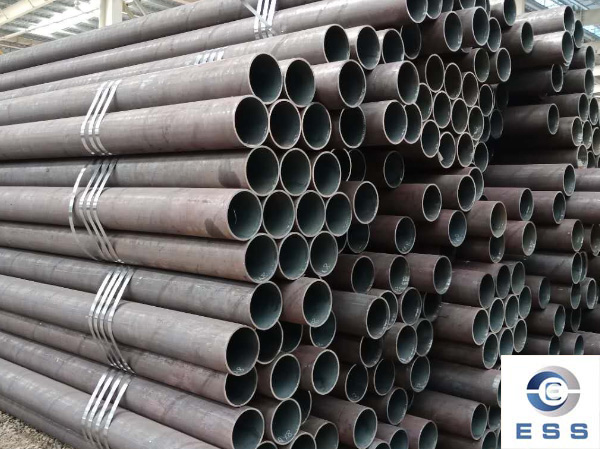Seamless steel pipe pressure calculation
Basic concepts of seamless steel pipes
Seamless steel pipes are made from steel ingots or solid tube blanks that are perforated into capillary tubes, and then hot rolled, cold rolled or cold drawn.
 Seamless steel pipe processing flow
Seamless steel pipe processing flow
The raw material for rolling national standard steel pipes is round tube billet. The round tube billet must be cut by a cutting machine into a billet with a length of about 1 meter, and sent to the furnace for heating via a conveyor belt.
The billet is fed into the furnace and heated to a temperature of approximately 1,200 degrees Celsius. The fuel is hydrogen or acetylene.
Temperature control in the furnace is a key issue. After the round tube comes out of the furnace, it must be pierced by a pressure punching machine.
Generally, the more common piercing machine is the tapered roller piercing machine. This type of piercing machine has high production efficiency, good product quality, large perforation diameter expansion, and can penetrate a variety of steel types.
After perforation, the round tube blank is successively cross-rolled, continuous rolled or extruded by three rollers. After extrusion, the pipe should be removed and calibrated. The sizing machine rotates a tapered drill bit at high speed into the steel blank to drill holes to form a steel pipe.
The inner diameter of the steel pipe is determined by the outer diameter length of the drill bit of the sizing machine. After the national standard steel pipe is sized, it enters the cooling tower and is cooled by spraying water. After the steel pipe is cooled, it will be straightened. After straightening, the steel pipe is sent to the metal flaw detector (or hydraulic test) by a conveyor belt for internal flaw detection.
If there are cracks, bubbles and other problems inside the steel pipe, they will be detected. After quality inspection, steel pipes must undergo strict manual selection. After the quality inspection of the steel pipe, spray the serial number, specification, production batch number, etc. with paint. And it is hoisted into the warehouse by a crane.
Seamless steel pipe pressure calculation
1: Calculation method for the outer diameter, specifications and wall thickness of national standard seamless pipes to withstand pressure (different materials of steel pipes have different tensile strengths)
Pressure = (wall thickness * 2 * steel pipe material tensile strength) / (outer diameter * coefficient)
2: The calculation method for calculating the wall thickness of seamless steel pipes when the outer diameter and pressure of seamless steel pipes are known:
Wall thickness = (pressure * outer diameter * coefficient) / (2 * tensile strength of steel pipe material)
3: Expression method of seamless pipe pressure coefficient:
Steel pipe pressure P<7Mpa coefficient S=8
7
Steel pipe pressure P>17.5 coefficient S=4
Classification of seamless steel pipes
The production process of general seamless steel pipes can be divided into two types: cold rolling and hot rolling. In appearance, cold-rolled seamless steel pipes are shorter than hot-rolled seamless steel pipes. The wall thickness of cold-rolled seamless steel pipes is generally thicker than that of hot-rolled seamless steel pipes. Be small. But the surface looks brighter than thick-walled seamless steel pipes. The surface is not too rough, and the caliber does not have too many burrs.
Seamless steel pipe application fields
Construction: Seamless steel pipes are an important material in the construction sector, especially in high-rise buildings and large structures. In construction, seamless steel pipes are used to bear the weight between floors and support frame structures. In addition, seamless steel pipes are also used for the installation of stage background frames and new energy equipment.
Oil and Gas: Seamless steel pipe is one of the most commonly used materials in the oil and gas industry. In the production, processing and transportation of oil and natural gas, seamless steel pipes can be used to withstand high pressure and temperature to ensure the safe operation of production lines.
Automotive and Machinery: Seamless steel pipes are widely used in the automotive and mechanical industries, especially for the manufacture of pipes for engines, driveshafts, suspension systems and braking systems.
Chemical industry: The chemical industry requires highly corrosion-resistant pipes, and seamless steel pipes can meet this requirement through surface treatment and material selection. They are commonly used for the transfer and storage of hazardous and corrosive chemicals.
Food and pharmaceutical: Seamless steel pipes are also used in the manufacture of food and pharmaceutical equipment, meeting high hygiene and structural requirements.
Read more: Seamless pipe weight calculation formula













 Eastern Steel Manufacturing Co.,Ltd not only improve product production and sales services, but also provide additional value-added services. As long as you need, we can complete your specific needs together.
Eastern Steel Manufacturing Co.,Ltd not only improve product production and sales services, but also provide additional value-added services. As long as you need, we can complete your specific needs together.










